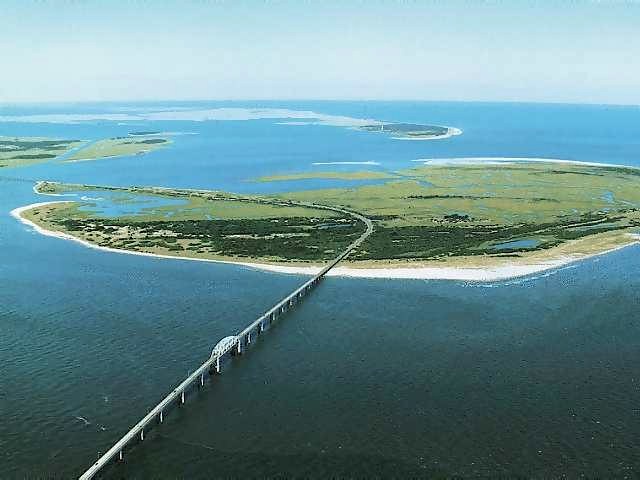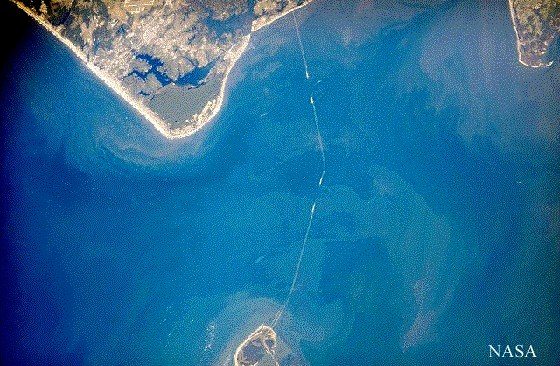CBBT Part 2

|
Chesapeake Bay Bridge-Tunnel - Part 2
1960–1964 building the CBBT: In the summer of 1960, the Chesapeake Bay Ferry Commission sold $200
million in toll
revenue bonds to private investors, and the proceeds were used to finance the
construction of the Bridge-Tunnel. Funds collected by future tolls were pledged
to pay the principal and interest on the bonds. No local, state or federal tax
funds were used in the construction of the project. Construction contracts were awarded to a consortium of Tidewater Construction Corporation and Merritt-Chapman & Scott Corporation. The steel superstructure for the high-level bridges near the north end of the crossing were fabricated by the American Bridge Division of United States Steel Corporation. Construction of the Bridge-Tunnel began in October 1960 after a six month process of assembling necessary equipment from worldwide sources. The tunnels were constructed using the technique refined by Ole Singstad with the Baltimore Harbor Tunnel, whereby a large ditch was first dug for each tunnel, into which was lowered pre-fabricated tunnel sections cable-suspended from overhead barges. Interior chambers were filled with water to lower the sections, the sections then aligned, bolted together by divers, the water pumped out, and the tunnels finally covered with earth. The construction was accomplished under the severe conditions imposed by nor'easters, hurricanes, and the unpredictable Atlantic Ocean. During the Ash Wednesday Storm of 1962, much of the work partially completed and a major piece of custom-built pile driver barge called "The Big D" were destroyed. Seven workers were killed at various times during the construction. In April 1964, 42 months after construction began, the Chesapeake Bay Bridge-Tunnel opened to traffic, and the ferry service was discontinued.
CBBT and Lucius J. Kellam Jr: The Ferry Commission and transportation district it oversees, created in 1954, were later renamed for the revised mission of building and operating the Chesapeake Bay Bridge-Tunnel. The CBBT district is a public agency and it is a legal subdivision of the Commonwealth of Virginia. However, the Bridge-Tunnel is supported financially by the tolls collected from the motorists who use the facility. Eastern Shore native, businessman, and civic leader Lucius J. Kellam Jr. (1911–1995) was the original Commission's first chairman. In a commentary at the time of his death in 1995, the Norfolk-based Virginian-Pilot newspaper recalled that Kellam had been involved in bringing the multi-million-dollar bridge-tunnel project from dream to reality. Before it was built, Kellam handled a political fight over the location, and addressed concerns of the U.S. Navy about prospective hazards to navigation to and from the Norfolk Navy Base at Sewell's Point. Kellam was also directly involved in the negotiations to finance the ambitious crossing with bonds. According to the newspaper article, "there were not-unfounded fears that (1) storm-driven seas and drifting or off-course vessels could damage, if not destroy, the span and (2) traffic might not be sufficient to service the entire debt in an orderly way. Sure enough, bridge portions of the crossing have occasionally been damaged by vessels, and there was a long period when holders of the riskiest bonds received no interest on their investment." An icon of eastern Virginia politics, Kellam remained chairman and champion of the CBBT throughout the hard times, and the bondholders were eventually paid as toll revenues caught up with expenses. He continued to serve until he was over 80 years old, finally retiring in 1993. He had held the post for 39 years. The facility was renamed in his honour in 1987, over 20 years after it was first opened to traffic.
One of the Seven Engineering Wonders of the Modern World: Following the CBBT's opening in 1964, it was selected by the American Society of Civil Engineers (ASCE) as "One of the Seven Engineering Wonders of the Modern World" in a worldwide competition that included more than one hundred major projects. The individual components of the Bridge-Tunnel are not the longest or the largest ever built. However, the total project was unique in the number and different types of major structures included in one crossing - including trestles, tunnels, artificial islands, bridges, causeway and approach roads — and that it was built under adverse conditions and for adverse conditions. The CBBT is no longer on the ASCE list, having been replaced by a more recent engineering wonder.
Info sign at the rest area with map of new bridge 1995–1999 additional trestles and lanes added: At a cost of $197 million, new parallel two-lane trestles were built both to alleviate traffic and for safety reasons.
Immediately after completion of the parallel trestles, traffic was diverted to
them and the original trestles and roadway underwent a $20 million retrofit,
repairing the wear and tear of 35 years of service and upgrading certain
features, such as repaving the road surface. The older portion of the facility
was then reopened on the 19th of April 1999. The 1995 - 1999 project increased
the capacity of the above-water portion of the facility to four lanes, added
wider shoulders for the new southbound portion, facilitated needed repairs, and
provided protection against a total closure should a trestle be struck by a ship
or otherwise damaged (which had occurred twice in the past); partially for this
reason, the parallel trestles are not located immediately adjacent to each
other, reducing the chance that both would be damaged during a single
incident. Into the future: CBBT tunnel needs and options: While there has been planning work done to expand tunnel capacities as well, the facility currently continues to utilize only the original two-lane tunnels. Plans to replace the two-lane tunnels with new and deeper four-lane versions were postponed indefinitely in 2005 at the direction of the Virginia General Assembly. Debate centered around the facts that while greater bay shipping and security would be enhanced by replacing the existing tunnels, the traffic counts and substantial cost estimates dictate that improvements for other water crossings in the Hampton Roads area may become higher priorities. The estimated cost of replacing the tunnels was $900 million. Despite Virginia's deepening unmet transportation needs in the years since, the finances of the Chesapeake Bay Bridge-Tunnel Commission have been kept separately as recommended to the General Assembly in a 2002 report of the Joint Legislative Audit and Review Commission (JLARC). The study concluded that "given the inability of the state to fund future capital requirements of the CBBT, the District and Commission should be retained to operate and maintain the Bridge-Tunnel as a toll facility in perpetuity.”
Operations, maintenance and regulations: Toll collection facilities are located at the both ends of the facility.
Tolls are paid in each direction. As of 2010, the toll for cars (without
trailers) traveling along the CBBT is $12. However, should a car make a return
trip within 24 hours of the first, the second trip across only costs $5.
Motorcycles pay the same toll as cars without trailers. All other vehicles are
charged based on size and purpose and are not subject to the return trip
discount. All tolls must be paid either in cash, by scrip tickets issued by the
CBBT, or via E-ZPass electronic
toll collection. The Bridge-Tunnel began accepting Smart
Tag/E-ZPass payments on the 1st of November 2007. All toll lanes including E-ZPass-only lanes are gated for several
safety concerns and to turn around inadmissible vehicles. For example:
· Strong winds have blown over certain vehiclesTherefore, some vehicles
are banned when the wind speed exceeds 40 miles per hour (64 km/h) and
level 5 wind restrictions with hurricane force winds and other inclement weather
conditions ban all traffic. · Hazardous
materials and compressed
gas require various restrictions and inspections to safeguard the
tunnels. · Both tunnels have the height limit of 13 feet 6 inches. An
over-height truck in April 2007 severely damaged the tunnels. Repairs took three
weeks. · Should police activities, accidents, or closures stop traffic from
moving freely, gates prevent drivers from entering and then being forced to turn
around within the narrow space or to wait too long in the middle of the
bridge-tunnel. · The bridge-tunnel management prohibits bicycles but offers a shuttle
van for $12 USD. Cyclists must call ahead. It is mandatory that the bridge be
checked and serviced every five years. Since servicing the bridge takes about
five years, the work never stops. · The Chesapeake Bay Bridge-Tunnel is the only transportation facility in Virginia that employs its own police department which, by original charter from the Commonwealth, has authority to enforce the laws of Virginia. Emergency call boxes are spaced every half mile along the bridge. The toll schedule, weather advisories and other information are available at the official website for the bridge.
Dimensions: Among the key features of the Chesapeake Bay Bridge Tunnel are two
1-mile tunnels beneath Thimble Shoals and Chesapeake navigation channels and two
high-level bridges 75 ft over two other navigation channels: North Channel
Bridge and Fisherman Inlet Bridge. The remaining portion comprises 12 miles of
low-level trestle, 2 miles of causeway, and four man-made islands. The CBBT is 17.6 miles long from shore to shore, crossing what is
essentially an ocean strait. Including land-approach highways, the overall
facility is 23 miles long (20 miles from toll-plaza to toll-plaza) and despite
its length, there is only a height difference of 6 inches from the south to
north end of the bridge-tunnel. Man-made islands, each approximately 5.25 acres
in size, are located at each end of the two tunnels. Between North Channel and
Fisherman Inlet, the facility crosses at-grade over Fisherman
Island, a barrier
island which is part of the Eastern
Shore of Virginia National Wildlife Refuge administered by the U.S.
Fish and Wildlife Service. The Bridge-Tunnel's concrete supporting columns are called piles.
If placed end to end, the piles would stretch for about 100 miles, roughly the
distance from New
York City to Philadelphia. Tourism: The CBBT promotes the bridge-tunnel as not only a transportation facility to tourist destinations to the north and south, but as a destination itself. For travelers headed elsewhere, the bridge-tunnel can save more than 90 miles of driving for those headed between Wilmington, Delaware (and points north) and the Virginia Beach area or the Outer Banks of North Carolina, according to the CBBT district. Unlike the Interstate highways that travelers would avoid by taking the bridge-tunnel, however, the roads in the shortcut have traffic lights. On the Delmarva peninsula to the north of the bridge, travelers may visit nearby Kiptopeke State Park, Eastern Shore National Wildlife Refuge, Fisherman Island National Wildlife Refuge, campgrounds and other vacation destinations. To the south are tourist destinations around Virginia Beach, including First Landing State Park, Norfolk Botanical Garden, Virginia Beach Maritime Historical Museum, Atlantic Wildfowl Heritage Museum and Virginia Aquarium and Maritime Science Centre. Drivers may stop at both the scenic overlook at the north end of the bridge and at Sea Gull Island, near the south end. At Sea Gull Island, passing ships may include U.S. Navy warships, nuclear submarines and aircraft carriers, as well as large cargo vessels and sailing ships. The CBBT authority runs a restaurant and gift shop on the island. Fishing is encouraged from the 625-foot long pier, which is open 24 hours a day, year-round. Restrooms, fish-cleaning stations and a certified weighing station are at the pier. Bluefish, trout, croaker, flounder and other species have been caught from the pier. Since birds use the habitat created by the bridges and islands of the CBBT, birders have travelled to the bridge-tunnel to see them at Sea Gull Island and the scenic overlook at the north end. The last picture is the CBBT seen from space (NASA). Amazing.
ALL IN ALL IMPRESSIVE TO SAY THE VERY LEAST QUITE A WOW
|




